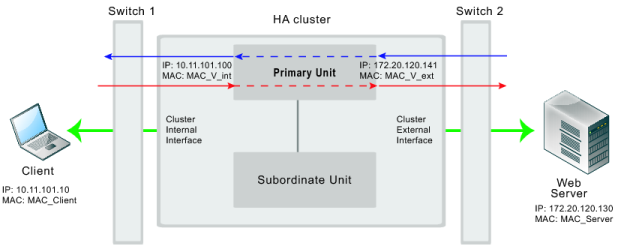NAT/Route mode active-passive cluster packet flow
This section describes how packets are processed and how failover occurs in an active-passive HA cluster running in NAT/Route mode. In the example, the NAT/Route mode cluster acts as the internet firewall for a client computer’s internal network. The client computer’s default route points at the IP address of the cluster internal interface. The client connects to a web server on the Internet. Internet routing routes packets from the cluster external interface to the web server, and from the web server to the cluster external interface.
In an active-passive cluster operating in NAT/Route mode, four MAC addresses are involved in communication between the client and the web server when the primary unit processes the connection:
• Internal virtual MAC address (MAC_V_int) assigned to the primary unit internal interface,
• External virtual MAC address (MAC_V_ext) assigned to the primary unit external interface,
• Client MAC address (MAC_Client),
• Server MAC address (MAC_Server),
In NAT/Route mode, the HA cluster works as a gateway when it responds to ARP requests. Therefore, the client and server only know the gateway MAC addresses. The client only knows the cluster internal virtual MAC address (MAC_V_int) and the server only know the cluster external virtual MAC address (MAC_V_int). Cluster virtual MAC addresses are described in
“Cluster virtual MAC addresses”.


